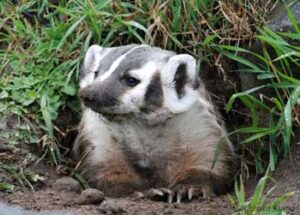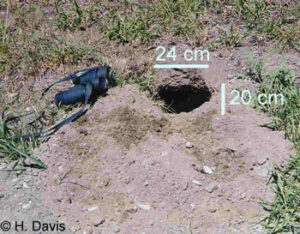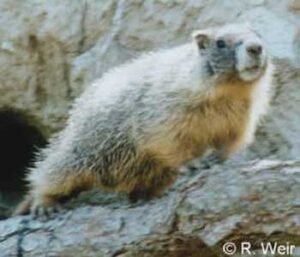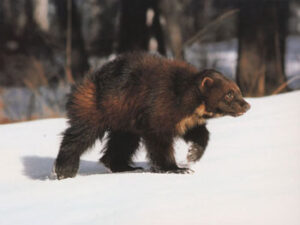Fun Facts About American Badger
The subspecies of badger found in British Columbia (Jeffersonii subspecies) is classified as endangered because:
- Their habitat is being negatively affected by human development. Badgers seem to need some component of grassland to survive. Urban development and agriculture can reduce the suitability of these dwindling habitats for badgers.
- In the early 1900’s, badgers were widely persecuted because of the perception that they were an agricultural pest. Many landowners feared that the large burrows dug by badgers posed a threat to livestock. People tend to be more tolerant of badger burrows nowadays, but the populations probably did not fully recover.
- Many badgers die each year trying to cross busy highways, roads, and railway lines. Humans are still a great cause of death within badger populations in British Columbia.
 Badgers are members of the Weasel family, related to wolverines, otters, fishers, martens, and minks. They are the only carnivore in Canada that burrows after and eats other burrowing animals. Badgers are important predators of pocket gophers, marmots, and ground squirrels, and they keep numbers of these rodents in check.
Badgers are members of the Weasel family, related to wolverines, otters, fishers, martens, and minks. They are the only carnivore in Canada that burrows after and eats other burrowing animals. Badgers are important predators of pocket gophers, marmots, and ground squirrels, and they keep numbers of these rodents in check.
 The species of badger that occurs in North America is the North American badger (Taxidea taxus. Photo left) – somewhat related, but quite different, to the European badger (Meles meles. Photo right).
The species of badger that occurs in North America is the North American badger (Taxidea taxus. Photo left) – somewhat related, but quite different, to the European badger (Meles meles. Photo right).
 Badgers are very distinctive looking, especially their faces. Badgers have a noticeable white stripe that runs down the top of their head, often from the tip of their nose all the way to their shoulders!
Badgers are very distinctive looking, especially their faces. Badgers have a noticeable white stripe that runs down the top of their head, often from the tip of their nose all the way to their shoulders!
The black cheek patches (called “badges”) are how badgers get their name. Badgers are stout, shaggy animals that look very “flattened” because their hair is short on their backs and long on their sides.
Badgers are about 60-90 cm (2-3 ft) in length and generally weigh about 7-8 kg (15.4-17.6 lbs) for adult females and 10-14 kg (22-30.8 lbs) for adult males.
An interesting fact about badger is that their forefeet are much larger than their hindfeet (unlike most mammals). This is because badgers dig for both food and shelter with their front feet, and they have huge front claws and small back claws to do this most efficiently. Don’t worry – badgers do not use their claws as weapons!
- In British Columbia, badgers are thought to live in the dry southern valleys that have grasslands, shrub-steppe habitats, or open forests of ponderosa pine or Douglas-fir.
- Badgers live a solitary existence, spending time together only during mating and when kits (badger babies) are still dependent upon their mothers.
- Badgers typically need two things to live in an area—lots of food to eat and places to dig their burrows.
- Badgers are amazingly powerful animals, capable of digging into the most hardened soil in pursuit of prey. Badgers dig incredibly quickly—up to a metre deep in a minute! Old badger burrows are also important for other creatures that can’t dig their own homes. The endangered burrowing owl is one such animal, but several rare snakes also use burrows for shelter.
 Badgers are carnivores and they eat pretty much any small creature they can catch. Their favourite prey includes Columbian ground squirrels (often referred to as “gophers”), yellow-bellied marmots, and northern pocket gophers, but they also eat meadow voles, red-backed voles, grouse, and even the occasional rattlesnake! Badgers capture many of their prey by chasing them into burrows and digging out the hapless prey.
Badgers are carnivores and they eat pretty much any small creature they can catch. Their favourite prey includes Columbian ground squirrels (often referred to as “gophers”), yellow-bellied marmots, and northern pocket gophers, but they also eat meadow voles, red-backed voles, grouse, and even the occasional rattlesnake! Badgers capture many of their prey by chasing them into burrows and digging out the hapless prey.
 Badgers dig holes that are slightly elliptical or round in shape, on average 24 cm wide and 20 cm high. The burrows created by badgers have distinct horizontal claw marks in the sides of the burrow (often up to 1.5 cm between claw marks) and it is sometimes possible to find badger hairs at the entrance or in the soil that has been excavated. The “plume” of soil at the entrance to the burrow is quite noticeable and often up to 2 metres in length. Holes dug by yellow-bellied marmots are smaller and lack the lateral claw marks, although both species can be occasionally seen coming from the same hole! Dens of coyotes and foxes are bigger than badger burrows and their entrances are often triangular in shape, with the claw marks running vertically from the peak of the entrance.
Badgers dig holes that are slightly elliptical or round in shape, on average 24 cm wide and 20 cm high. The burrows created by badgers have distinct horizontal claw marks in the sides of the burrow (often up to 1.5 cm between claw marks) and it is sometimes possible to find badger hairs at the entrance or in the soil that has been excavated. The “plume” of soil at the entrance to the burrow is quite noticeable and often up to 2 metres in length. Holes dug by yellow-bellied marmots are smaller and lack the lateral claw marks, although both species can be occasionally seen coming from the same hole! Dens of coyotes and foxes are bigger than badger burrows and their entrances are often triangular in shape, with the claw marks running vertically from the peak of the entrance.
Check out the Badger Burrow ID Card for more details!
In British Columbia, badgers can sometimes be confused with yellow-bellied marmots. Both live in open forests and dig burrows. However, marmots are rodents that hibernate in winter and are slightly smaller than badgers. The greatest distinguishing characteristics of badger are the white stripe from the nose to the top of the head, white cheeks, and a black patch (“badge”) in front of each ear.
Some animals that may be mistaken for badgers:
Yellow-bellied marmot

Habitat: Grasslands and open forests
Commonly seen: near rock or slash piles, also seen sunning themselves on concrete roadside barriers
Differences from badgers:
- Lacks white stripe down nose
- White markings surrounding nose and mouth
- Slightly smaller size: ~4 kg [9 lb.] versus 8-12 kg [15-27 lb.] for badgers
- Not as “flat” as badgers
- “Squeak” when distressed
Similarities with badgers:
- Dig and live in burrows in the soil
- Yellow-grey colouration
- Occur in same grasslands and dry forests of the Thompson and Okanagan regions
Wolverine
 Habitat: Mountainous regions and boreal forests
Habitat: Mountainous regions and boreal forests
Commonly seen: Not common; occasionally seen in alpine areas or wooded mountain regions
Differences from badgers:
- Lacks white stripe down nose
- Generally darker colour (chocolate brown)
- Light-coloured stripe runs down side of body and over rump
- Not as “flat” as badgers
- Doesn’t commonly burrow into ground
- Exceptionally rare in grasslands or dry forests
- Most common in central and northern British Columbia
Similarities with badgers:
- Very similar body size: 8-14 kg [15-31 lb.]
- Not commonly seen
Badgers have several unique adaptations that make them interesting animals:
- They are the only true burrowing predator in Canada and are important for the control of burrowing rodents.
- Their abandoned burrows are used by the endangered burrowing owl as nesting sites.
- Other rare species use their abandoned burrows for homes, too – such as gopher snakes, rattlesnakes, and possibly rubber boas.
Absolutely! Please read “The Badger – A Species at Risk” on Parks Canada’s website.

